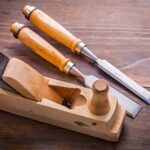Introduction to Woodworking Chisels
Woodworking chisels have been around for centuries, and with their utility source of cutting and shaping wooden structures, they remain a popular tool to this day. While some of the earliest chisels were made from animal bones and flint, today’s chisels are typically constructed from metals such as steel, which retains an extremely sharp edge and is resistant to wear.
The anatomy of a chisel includes a blade (the cutting edge), a bolster between the blade and the handle for extra strength, and a tang (the part into which the handle is inserted). Depending on their use, different shapes are available; three of the most common types being gouges, firmer chisels, mortise chisels. Gouges have curved blades designed to cut large concave curves in softer woods while firmer chisels are used to perform fine paring cuts on hardwoods. Mortise chisels have wide beveled edges made for constructing mortise-and-tenon joints in furniture. Certain properties of any given woodworking chisel should be taken into consideration when choosing one including its alloy type (carbon or stainless steel) as well as its bevel angle—33 or 50 degrees —depending on the specific application.
Due to their versatility, woodworking chisels can create highly detailed joints and finishes in hardwoods like oak and walnut that simply would not be possible using other tools such as circular saws or routers. Furthermore, since there is no electricity required for these tools it makes them ideal for outdoor projects where access to electricity may not be available.
Choosing the Right Chisel
The type of woodworking project you’re undertaking plays a large role in determining which chisel you should use. If your project involves general carpentry, such as furniture construction or planing, then you’ll need mainly a variety of common bench chisels including a wide range of sizes. These are the most versatile and basic chisels, and they can handle most projects with ease. For honing and finishing, Takagi has some great chisels that have beveled edges to really fine tune your work. They come in several different sizes as well as left-handed varieties for those who prefer that style.
For carving projects such as sculptures or organic artwork, different options exist. Extra long gouges are handy for more intricate projects and can reach deeper holes easier than standard benches. Japanese brands like Kyoshin Ryu offer excellent quality carving tools with sharpened edges and precision-crafted handles.
Abrasives like rasps may also be needed for texturing woods or removal of curved shapes depending on the type of look you want to achieve. These abrasive implements can be invaluable when trying to achieve specific types of contours or crevices in the wood that aren’t possible with smoother edged tools alone. Brands like General Tools make affordable yet reliable rasps that are perfect for professional woodworkers and newbies alike.
No matter what type of woodworking project you’re getting ready to tackle, finding the right tool will make all the difference in terms of success and ease. There is no shortage of quality manufacturers out there making quality tools, so it really comes down to personal preference when deciding between them all!
Best Practices For Handling Chisels
Chisels should always be handled with the utmost caution in order to prevent accidents which could result in serious injury.
When preparing to use a chisel, ensure that you are wearing the appropriate personal protective equipment (PPE) such as safety goggles and gloves. Always secure your work piece by clamping it securely so that it does not move. If possible, secure your chisel as well so that it remains steady when in use.
Make sure the cutting edge of your chisel is sharpened before you begin using it on any material. Dull blades can increase the risk of slipping during operation and cause harm to both you and your workpiece.
Keeping a firm grip on the handle is essential for safety. Always maintain full control over your chisel at all times when using it. Ensure that you keep other objects away from your point of operation to prevent damage or injury from occurring.
Finally, proper disposal techniques should also be observed. Sharp objects such as chisels should be placed into secure storage containers away from children and unauthorised personnel when they’re not being used. Make sure to properly dispose of used cutting edges since blunt tips can be a hazard if left lying around carelessly.
Demonstrations videos or pictorials are helpful resources in understanding how best to use and handle woodworking chisels correctly and safely, therefore these materials should accompany any guidance presented on this subject-matter
Sharpening Chisels
Sharpening chisels is a must for any woodworker. Keeping your chisels in top condition means having sharp, clean edges that will give you the best results when working with wood. Unfortunately, many beginners do not take the time to sharpen their chisels correctly, resulting in poor cuts and damaged wood. To get the best performance from any woodworking project, sharpening chisels should be an important part of your tool arsenal.
When it comes to sharpening techniques amongst experienced woodworkers, there are several approaches available depending on what kind of timber or material you’re working with and how much time or effort you have to spare. For those who want a fast and easy method yet still desire a sharp edge, diamond files and slip stones are popular options. If accuracy is your goal, then honing guides (or also called jigs) prove more effective as they help keep your blades aligned correctly while you work and offer greater control when changing angles. Additionally electric powered wet grinders and belt sanders provide quick solution for bringing a blunt edge back to life in no time at all.
To gain further insight into this topic we can interview some seasoned professionals who have had extensive experience with various types of tools throughout the years. We can ask them how they approach the task of re-sharpening jaws for salvaged planes or if they prefer one type of stone over another for sharpening chisels when working with composite woods or veneers, along with what tips they might have to pass on from personal experiences using different types of machines and methods for getting that razor-like finish on their end pieces!
Maintenance and Care
Cleaning: After use, clean chisels with a damp cloth to remove any chips or dirt. Then dry completely. If you are working with wood that contains sap, use a solvent such as paint thinner to clean the blade. Avoid using abrasive cleaners which can damage the blade.
Storing:To ensure your chisel lasts, store it in a protective case or cover. If this isn’t available, wrap it in cloth and place it in a wooden tool box or drawer with other cutting tools so the edges don’t become damaged when not in use. In a workshop setting, store your tools on metal racks away from moisture and temperatures extremes like direct sunlight or heating outlets so they are not exposed to unnecessary wear and tear.
Care: Keep an eye on the blades of your beginner woodworking chisels and inspect them regularly for irregularities – rust spots, nicks and cracks etc. Blade sharpening is also important for optimal performance of your woodworking tasks – always keep in mind that you should never sharpen chisels entirely by hand; Instead use a grinding stone that has been slightly moistened or oiled according to manufacturer’s instructions which will help increase the sharpness of the edge while minimizing heat buildup which can result in brittleness and cracking of the blade material. Finally, always remember to work safely and wear safety glasses when handling any type of cutting tool like chisels!
Projects to Try
Project 1: Making a Handcrafted Doorstop
Materials:
– Chisel
– 3 feet of 1 inch x 4 inch lumber (or in a thickness of your choice)
– A small weight
– Glue
– Sandpaper
Instructions:
1. Take your chisel and create two depressions in the middle of the faceboard on each end, approximately 6 inches from either side. The size of the depression should be slightly bigger than the weight that you are using for the doorstop. These depressions will allow for a secure fit for the weight.
2. Cut out three pieces to form a triangle shape, with one piece being longer than the other two. Make sure that all pieces are cut to length and the angles are precise by double checking all measurements before proceeding with assembly.
3. Joint and glue together your three pieces to form a triangle base to support your stop. Allow enough time for it to dry before continuing!
4. Lightly sand and finish off any rough edges where you have used chisel or saw cuts earlier, ensuring all edges are smoothed over completely – this prevents any splinters or discomfort when handling after it is complete!
5. Place your weight into its recesses in the wooden frame you have created – secure with Gorilla Glue if necessary – and allow extra drying time for it to adhere properly before placing on your floor!
Conclusion
In conclusion, it is clear that beginner woodworkers need to start their project with the right tools. Woodworking chisels are essential for completing many tasks and should be chosen for their functionality, design, size and balance. It is important to purchase quality tools from a trustworthy source or a major hardware store chain. Additionally, having the proper sharpening tools and techniques will extend the life of your chisel. As you begin your woodworking journey, there are professional woodworking organizations for further resources and support including The Woodworker’s Guild of America, Craftsman Woodworking Guild, Fine WoodWorking Magazine, Woodwork Institute and The American Association of Woodturners.

Hi everyone! I’m a woodworker and blogger, and this is my woodworking blog. In my blog, I share tips and tricks for woodworkers of all skill levels, as well as project ideas that you can try yourself.





